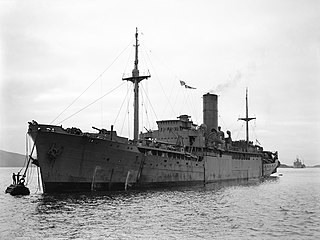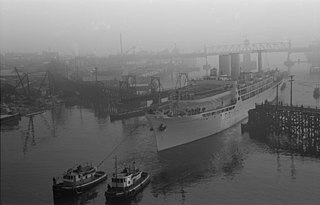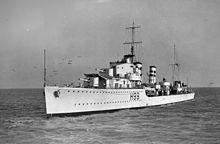
Alan-A-Dale was a cargo motor ship that was built in Denmark in 1938 as Nordvest. In the Second World War the United States requisitioned her in 1941 and renamed her Alan-A-Dale. In 1944 she was sunk by enemy action off the coast of the Netherlands.

Jun'yō Maru (順陽丸) was a cargo steamship that was built in Scotland in 1913, served a succession of British owners until 1927, and was then in Japanese ownership until a Royal Navy submarine sank her in 1944.

Ryusei Maru was a cargo steamship that was built in England in 1911 and sunk off the coast of Bali in 1944. She was launched as Bra-Kar for Fred. Olsen & Co. of Norway. In 1916 she changed owners and was renamed Havø. In 1935 she changed owners again and was renamed Mabuhay II.

Tango Maru (丹後丸) was a cargo motor ship that was built in Germany in 1926 and sunk off the coast of Bali in 1944. She was launched as Rendsburg for the Deutsch-Australische Dampfschiffs-Gesellschaft (DADG), which in 1926 merged with Hamburg-Amerikanische Packetfahrt-Actien-Gesellschaft (HAPAG).
SS Chenab was a steamship that was built in England in 1911 and scrapped in Scotland in 1953. For nearly two decades she was part of Nourse Line, which carried Girmityas from India to colonies in the Caribbean and the Pacific. In 1914 she was requisitioned for service in the First World War.

SS Minnedosa was one of a pair of transatlantic steam ocean liners that were built in the United Kingdom, launched in 1917 and operated by Canadian Pacific until 1935. Her sister ship was Melita.

USS Long Beach (AK-9) was a cargo steamship that was built in England in 1892 as Yarrowdale, passed through a succession of British, Greek and German owners, and was seized by the United States in 1917. She served in the US Navy until 1921, then in the US Merchant Marine, and was scrapped in 1924. She was called Nicolaos Castriotis in Greek ownership, Hohenfelde in German ownership, and Golden Gate from 1923.

SS Potsdam was a steam ocean liner that was launched in Germany in 1899 for Holland America Line. In 1915 Swedish American Line acquired her and renamed her Stockholm.

USS Charlton Hall (ID-1359) was a cargo steamship that was built in Scotland in 1907 and served in the merchant fleets of the United Kingdom, United States and Greece. She served in the United States Navy in 1918. She was renamed Atlantis and then Anastasis in 1930. She was scrapped in China in 1934.

USS General W. C. Gorgas (ID-1365) was a cargo liner that was launched in Germany in 1902 as Prinz Sigismund for the Hamburg America Line. In 1917 the USA seized her and renamed her General W. C. Gorgas. In 1945 she was transferred to the Soviet Union, which renamed her Mikhail Lomonosov. She was scrapped in March 1958.

SS Polar Chief was a merchant steamship that was built in England in 1897 and scrapped in Scotland in 1952. In her 55-year career she had previously been called Montcalm, RFA Crenella, Crenella, Rey Alfonso, Anglo-Norse and Empire Chief. Early in the First World War she spent eight months pretending to be the battleship HMS Audacious.

Wickenburgh was a cargo liner that was built in 1938 as Adler by Lübecker Maschinenbau Gesellschaft, Lübeck for German owners. Requisitioned by the Kriegsmarine in 1940, she was seized by the Allies in Vordingborg, Denmark in May 1945, passed to the Ministry of War Transport (MoWT) and renamed Empire Coningsby. In 1946, she was transferred to the Dutch Government and renamed Margeca. In 1947 she was sold into merchant service and renamed Wickenburgh. In 1953 her compound steam engine and low-pressure steam turbine were replaced with a diesel engine, with a reduction in gross register tonnage from 1,494 to 1,420. She was sold to Greek owners in 1963 and renamed Nissos Thassos. In 1970 she was sold to Panamanian owners and renamed Savilco. She was scrapped in 1984.
SS Heidberg was a cargo steamship that was built in 1943 in Sweden for a German shipping company. The Allies in 1945 took it for war reparations. She was renamed Empire Convention, and spent about nine months under United Kingdom ownership and management. In 1946 she was transferred to the Soviet Union, who renamed her Эрнст Те́льман – Ernst Thälmann. Her fate is not recorded.

SS Themistocles was a UK steam ocean liner and refrigerated cargo ship. She was launched in 1910 in Ireland and scrapped in 1947 in Scotland. She was built for Aberdeen Line, White Star Line managed her for a few years, and she spent the latter part of her career with Shaw, Savill & Albion Line.

HMS Agamemnon was originally the Blue Funnel Line refrigerated cargo ship Agamemnon. She was built in 1929, traded between the UK and the Far East, and was scrapped in 1963. During the Second World War she was converted into an auxiliary minelayer in 1940, and then into an amenities ship in 1943.

HMS Menestheus was originally the Blue Funnel Line refrigerated cargo ship Menestheus. She was built in 1929, and traded between the UK and the Far East. She was an auxiliary minelayer from 1940 to 1943. In 1945, during the Second World War, she was converted into an amenities ship. She was scrapped in 1953 after being gutted by fire.

HMS Southern Prince was a motor ship that was built in 1929 as the refrigerated cargo ship Southern Prince. She was commissioned into the Royal Navy in 1940 as a minelayer. She became a headquarters ship and then an accommodation ship in 1944, was a fleet training ship in 1945, and returned to civilian trade in 1946. In 1947 she was sold to Italian owners who had her refitted as a passenger ship and renamed her Anna C. From 1952 she was a cruise ship. She was scrapped in 1972.

SS Lydia was a passenger ferry that was built in Scotland in 1890 for the London and South Western Railway. From 1920 onward she passed through several owners. In 1923 she was renamed Ierax and registered in Greece. She was scrapped in 1933.

SS Rio Tercero was a cargo steamship that was launched in England in 1912 as Eboe. She was renamed Fortunstella in 1938, and Rio Tercero in 1941. A U-boat sank her in the Battle of the Atlantic in 1942.
SS Melita was one of a pair of transatlantic steam ocean liners that were built in the United Kingdom, launched in 1917 and operated by Canadian Pacific until 1935. Her sister ship was Minnedosa.

















